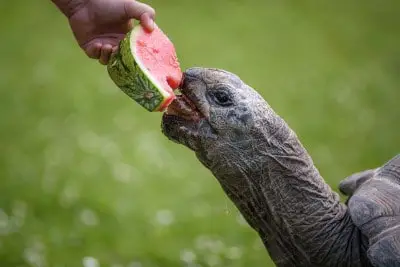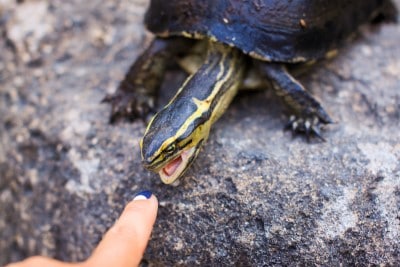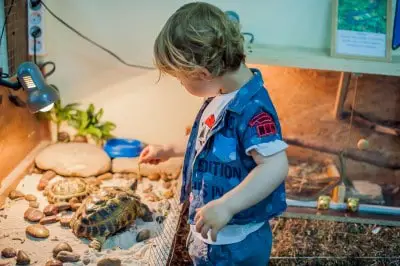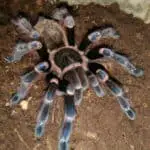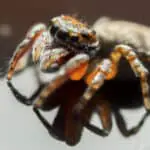Turtles are amazing creatures but are not as demanding as other pets, making it easier for you as a new owner to cater to them. The most critical decision you can make is what to feed them. The right food will improve the quality of life and help them grow healthy and happy. Otherwise, they can get weak, sick, and eventually die.
Turtles can feed on veggies such as kales, beans, and broccoli since they contain water, fiber, vitamins, and minerals; hence, they need them once a day. For juveniles, feed them on foods rich in protein such as chunks of cooked meat, small fish, worms, and insects like crickets.
Read on as we let you in on our dos and don’ts when feeding your turtle and break everything down to help kick start your turtle-owning journey.

Do Turtles Eat Vegetables?
Vegetables are one of the most nutritious turtle foods. First, they provide fiber and water and are also a great source of manganese, phosphorus, calcium, vitamins, and other essential nutrients. Calcium helps in solid bone development and the growth of a healthy shell. Therefore, your pet will be safe when it sheds its scutes to grow new ones. Secondly, these foods contain vitamins such as A, C, and K, which are vital for their general health.
Vitamin A enhances eyesight, C aids in healing, while K boosts their immunity. Other veggies also provide proteins for bodybuilding. We usually recommend kales, beans, peas, yams, squash, collard greens, celery, cucumber, and broccoli. These provide water for hydration and fiber for metabolism. They also contain sodium and potassium that serve as antioxidants.
For your pet’s improved health, we advise providing at least one vegetable a day since they are their staple meals when in their natural habitat and are highly nutritious. Some owners have challenges with certain types since turtles can be pretty picky; if you face the same, you can try vegetable pellets.
Remember to wash fresh green vegetables thoroughly before serving to get rid of any chemicals or impurities. Adult turtles are more herbivores than juveniles are; hence, you may need to switch to an exclusive veggie diet if you have a mature pet. On the contrary, there are some vegetables that you need to avoid.
Experts advise against excessive celery, spinach, and lettuce and recommend providing them as treats and not staple meals. First, celery doesn’t contain many essential nutrients but has high water content. Therefore, it only satisfies the turtle but is of no nutritional value. Spinach and lettuce, on the other hand, contain too much oxalic acid.
This component binds calcium, which is necessary for bone and shell growth. When your pet eats them as the main meal, it may suffer critical side effects such as kidney stones. Therefore, if your pet loves them, it is best to provide them as treats once in a while to avoid the side effects.
Do Turtles Eat Fruits?
Humans love fruits due to the savory taste and juiciness. Surprisingly, turtles love them too! Some owners use them as treats to encourage them to eat or during simple training to keep them motivated. As seen with vegetables, fruits also contain essential vitamins and minerals, which are great for the reptiles’ bodies. Some types like oranges contain vitamin C and A for faster healing and vision improvement, respectively.
Juicy fruits are also alternative water and fiber sources for better metabolism and excretion. The water eases bowels and eliminates the toxins in the body. On the downside, excessive fruits are not ideal for turtles due to the high starch content. In addition, these reptiles’ digestive systems are not as advanced as other animals; therefore, they cannot break down such complex foods.
Essentially, avoid grapes, watermelon, strawberries, bananas, apples, and mangoes. You can provide them as treats and in small amounts once a week, depending on your turtle species. However, when they eat more fruits, it can stress their digestive systems and lead to internal complications. Primarily, rarely avail them if your pet is aquatic. Your pets can also have limited amounts of cantaloupe, kiwi, oranges, and other fruit types that you would eat.
Also, be cautious with fruits that contain a lot of seeds, such as apples and watermelon. They are choking hazards and can cause cyanide poisoning to your pet. Additionally, turtles tend to get addicted to food they love; if you provide sweet fruits regularly, they may get picky with other more nutritious foods.
Do Turtles Eat Meat?
Most turtles adopt a carnivorous diet when they are younger and gradually become herbivorous in their maturity. Some species like the snapping and softshell turtles are primarily carnivorous and love indulging in fish and meat. Other herbivorous species like the green sea turtles would rather have a plant-based diet. Fortunately, most turtle pets are omnivorous, enjoying a little of both worlds.
Owners feed them small cooked meat chunks like beef, pork, and chicken. If you provide meat for the first time, it is advisable to introduce them slowly by providing meat in small bits first. It is because it contains proteins necessary for juveniles’ growth. However, it is best to provide them as a treat since excessive proteins can cause obesity in turtles. Consequently, your pet will suffer internal organ issues and other complications.
Moreover, meat makes the tank water dirty because it rots quickly. Preferably, provide cooked and not raw meat. It can cause food poisoning since it may carry salmonella and can decay before your pet eats it. It is wise to use a powerful filter to clean the tank to eliminate any remains that contaminate the water.
Do Turtles Eat Fish?
Aquatic turtles live with fish in their natural setup; therefore, they form the central part of their diet. They are a great source of proteins and calcium for your pet, particularly the actively growing turtles that require high protein intake for growth and development. Primarily, fingerlings and other small fish are the reptile’s delicacy. Different types contain different fat levels, and it is best to feed them to turtles only once in a while to avoid overfeeding.
On the flip side, older turtles will consume less fish since they have adopted a vegetarian lifestyle. If your pet is in captivity with no readily available fish, you may offer them feeders to spice up their diet. However, it would help if you were very cautious about hygiene. If you are providing fish, there are high chances that there will be leftover bits that can easily attract microorganisms resulting in water contamination and infections.
Depending on the size of your buddy and feeding behavior, you will tell how much fish they can consume; if it is a treat, a piece or two will suffice. Notably, avoid feeding them with live crayfish, shrimps, or larger fish because they can maim or injure your pet. Also, feeder goldfish isn’t ideal for turtles due to the strong bones that may hurt the animal’s gut.
Do Turtles Eat Insects?
Insects inhabit almost every environment making them an ordinary meal to most animals. Terrestrial and aquatic turtles love indulging in them as a favorite snack; however, they may eat different insect species depending on their current surroundings. These invertebrates are rich in proteins which make up over fifty percent of their body’s nutrient composition.
Their exoskeleton also has high calcium that is vital for strong bones and shells. Some insect species can play a crucial role in gut loading these animals when they are about to brumate. The most available insect species that are safe for turtles include grasshoppers, cockroaches, crickets, houseflies, and beetles. You can collect them yourself in your garden or buy dried ones at a pet store near you.
Due to the insects’ high-fat content, you should feed them as treats and not the main course. This way, you will have reduced overfeeding, a condition that can be fatal to your turtle’s health. Other insects such as spiders, ladybugs, and ant species may harm your turtle. Therefore, consulting with your veterinarian before serving your pet insects is prudent too.
Do Turtles Eat Pellets?
Pellets are a commercial turtle food that you can find in pet stores. They come in different flavors and nutrients, and you can get what is best for baby, juvenile, or older turtles. Some are rich in proteins, minerals, and vitamins, making them fit for younger and fast-growing turtles. Others contain vegetables and fruits, mixed or separately according to your preference as you would want it for the mature reptiles since they are on a vegetarian diet.
The vegetable pellets are remarkable for their health and improve their lifespan since they are nutritious. However, seldom treats of protein foods once a week wouldn’t harm your buddy. Essentially, pellets don’t need special storage, unlike fresh or live food that requires refrigeration to remain viable to eat.
Therefore, a commercial meal is easier to manage; you can serve it straight from the shop and more convenient to use with an automatic feeder, meaning your pet will be okay even when you go on vacation. You must serve fresh food in person and ensure that you remove the excess from the enclosure to maintain hygiene. It is advisable to feed your terrestrial shelled friend from a bowl for about fifteen minutes daily or twice a week for mature pets.
Do Turtles Eat Mollusks?
Mollusks are soft-bodied invertebrates that inhabit both land and water, especially oceans and freshwater bodies. Good examples of such species are snails, oysters, and octopuses. The turtles are likely to prey on small mollusks that they can comfortably munch but avoid the more prominent and intimidating ones. These invertebrates are a great addition to the turtle’s diet since they are rich in proteins, minerals, and natural fats that most growing turtles require for healthy living.
However, it would be best to be careful with overfeeding such foods since they may make your pet overweight. Terrestrial turtles, unlike the aquatic ones, rarely interact with snails. In captivity, you can buy a few mollusks and raise them for your pet to eat. You can also buy invertebrates from a pet store or raise them as feeders for your buddy. Avoid harmful types such as cone shells. It is necessary to seek professional advice before starting your buddy on such meals.
Do Turtles Eat Worms?
Naturally, turtles love meat more than they do plants, but the tables turn as they grow older. As with snails and insects, worms are a reliable protein source that your buddy would enjoy. Earthworms, silkworms, waxworms, and mealworms are the common foods for most turtles. Pets in the wild can easily hunt them down, while the domesticated ones may eat live or dead worms in pellet form. The dried ones are also rich in natural nutrients that are vital for your pet’s health.
You can also raise the worms at home specifically for the turtle’s feeding purposes since they are low maintenance. In addition, feed the reptile some proteins because it may cause health complications when in excess. Notably, juveniles will require several worms a day, unlike the mature turtles that only need them as treats. Lastly, be cautious with wild bloodworms because they can harm baby turtles.
Can Turtles Eat Human Food?
Some owners love experimenting with different foods when feeding their turtles. However, we strongly advise against some foods since they can cause grave harm to your turtle. Also, note that not every meal you consider tasty will be safe for your pet. For one, the human digestive system is different from that of turtles; therefore, your pet won’t digest everything you eat. Secondly, some human foods aren’t of any nutritional value to your pet.
These are snacks or luxury foods like sweets, chocolates, cakes, popcorn, or other sweet snacks. The sugar content is too much for your pet’s body and will only strain the system. Also, avoid junk items like fries, burgers, salted or fried food, bread, and other foods. The high calories can cause obesity in turtles, leading to complications like pyramiding and kidney stones.
Moreover, some human foods contain powerful chemicals as preservatives, which are stressful to the turtle’s organs. Turtles lack the essential enzymes to digest lactose in milk and other dairy products. Therefore, it is best to avoid offering your pet any cheese, yogurt, or other foods that may contain milk. If the turtles cannot digest the food, their digestive system may block, and other health conditions may follow.
Read more: 5 Best Turtle Food
Turtle Feeding Do’s and Don’ts
Turtles aren’t very fussy animals regarding their diet. They can comfortably eat various foods from flesh to vegetables because they are omnivorous and share most meals with humans. Turtles in the wild and those in captivity may experience different meals, but they have similar feeding habits. We compiled a list of the main dietary concerns that beginners should know.
Nutrition
Unlike other mammal pets, turtles are particular about their diet. Therefore, it is vital to provide the food choices that best incorporate the nutrients they need. For instance, they require water for hydration, flushing out toxins in the body, and softening their skin. Fiber helps in digestion and relieves constipation, while calcium assists in a healthy shell and strong bones. Additionally, they need vitamin A for good eyesight, vitamin C for faster healing, and vitamin K for immunity build-up. They also need a small amount of magnesium, phosphorus, proteins, and other essential nutrients.
Without vitamins in their diet, your turtle may suffer appetite loss, swelling of the external organs, kidney stones, and respiratory issues. In contrast, it is critical to avoid some foods that contain excessive proteins, oxalic acid, and phosphorus. This is because these reptiles’ digestive systems aren’t strong enough to break down these components; therefore, their organs strain themselves, leading to severe damage over time. For instance, excessive proteins cause obesity and shell pyramiding, which also interferes with their locomotion and other internal organ issues.
On the other hand, Oxalic acid hinders calcium absorption, interfering with bone and shell development, and contributes to Metabolic Bone Disease (MBD). It is also crucial to avoid low-nutrient foods such as celery and lettuce. They mostly contain water but don’t necessarily add other nutrients to your pet’s body. Secondly, eliminate human food with excess starch such as sweets, chocolates, bread, cakes, burgers, fries, and other snacks and junk. You may be unknowingly harming your pet in the process.
Hygiene
Turtles can be pretty messy, and it’s essential to ensure that their homes stay clean at all times. A clean tank and water improve their quality of life and make the tank an attractive centerpiece. There are several ways to ensure high hygiene standards between you, your loved ones, and your turtle. First, before you commence feeding, wash your hands thoroughly to prevent the transfer of bacteria from your hands to the animal.
Once they are satisfied, remove any remaining food particles that may contaminate the water and facilitate growth on disease-causing organisms. Prey or vegetable bits can quickly spoil the tank water and make your buddy sick. Other owners find it more convenient to have a separate feeding spot because turtles will eat and excrete in the same water they drink.
With this arrangement, your pet will always eat fresh food and drink clean water. Also, remember to wash the enclosure regularly to eradicate any fungi, algae, or bacteria. Finally, after feeding the reptile and handling your reptile, it is essential to wash your hands thoroughly using soap, water, or disinfectant to keep you safe from contracting salmonella infections.
How To Feed The Turtles
Unlike humans, turtles don’t eat regularly due to their slow metabolism. However, unique turtle species behave differently regarding their diet. Not all turtles will show similar preferences for particular foods; hence, you should expect rejection when you offer particular items for the first time. You can feed aquatic turtles by dropping their food in the water, while semi-aquatic and terrestrial turtles can eat on dry surfaces.
You can buy feeding platforms and place their food on it and let them come to eat of their own volition. It isn’t recommended to serve juveniles vegetables because they are carnivorous; hence, they need more meat and proteins for bodybuilding and physiological processes. On the other hand, mature turtles can tolerate vegetables better than hatchlings, and you can serve them lots of greens, fruits, and meat as treats, possibly once a week. Serve the turtles a particular food and see whether they like it.
If they don’t, change it as you experiment with different types until you get their favorites. To avoid choking, ensure that the food bits are approximately the same size as their head, let them eat for about fifteen minutes, and clear the remains. Lastly, besides fresh foods, occasional meat, and fruits, you can try pellets since reptiles love them, are nutrient-rich, and more convenient.
Species and Age
Your type of turtle will always determine your dietary choices. Primarily, hatchlings and juveniles need more portions and nutrient-rich foods since they are rapidly growing. They require a lot of protein, calcium, and vitamins for their well-being because their bodies are developing. A healthy diet for them means little or no problems in the future since they will have a robust digestive system and high immunity.
At this stage, they are primarily carnivorous and will mainly rely on a plant-based diet, while mature turtles don’t need excess proteins since they can get overweight. Over time, they slowly switch their lifestyles to be herbivorous. The most crucial factor to consider is your turtle’s species. Aquatic and semi-aquatic turtles have different nutritional requirements, and various subspecies react differently to different foods.
Given that their digestive systems are different, others will handle certain foods better. Snapping turtles, for instance, are generally carnivorous, meaning that their diet will mainly comprise meat. Therefore, it is critical to conduct more research on what your pet requires and consult a vet to be sure.
Overfeeding
Some owners struggle with not knowing the right portions and end up providing too much. Your guiding factor should be that turtles would rather eat small servings at a time; it is easier on their digestion and keeps your tank clean. Remember that excessive feeding can also cause obesity, such that your pet will find it hard to retreat to its shell. It helps to have a large aquarium for them to have a lot of exercise and move freely. Some parents also feed their pets live food to help them hunt and stay active.
Also read: Best Automatic Turtle Feeders
Parting Shot
Turtles are unique exotic pets that need the best care, especially when it comes to their diet. They are mostly omnivorous, but juveniles are more carnivorous, while adults would rather have a plant-based diet. Turtles can eat vegetables, meat, fish, insects, and fruits since they are highly nutritious. However, we advise against excessive fruits and meat that contain a lot of starch and proteins, respectively. Also, avoid human foods like snacks, junk and dairy products because they don’t provide any essential nutrients to their bodies and will only stress their digestive systems.

